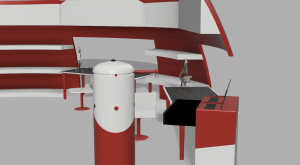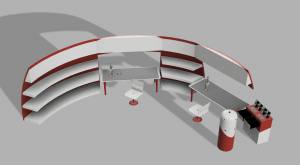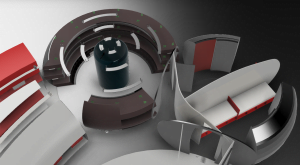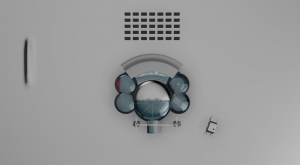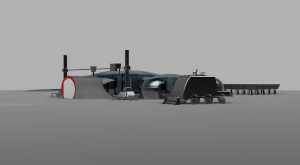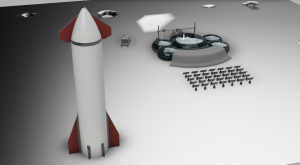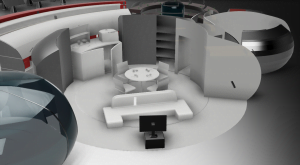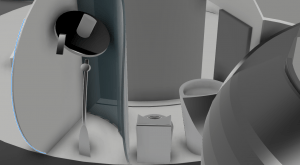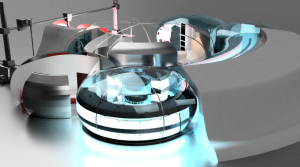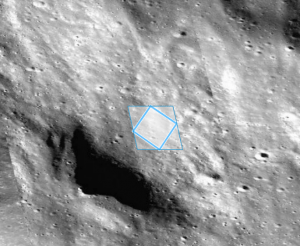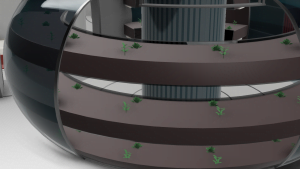Moon Camp Pioneers Gallery 2020-2021
In Moon Camp Pioneers each team’s mission is to 3D design a complete Moon Camp using Fusion 360. They also have to explain how they will use local resources, protect astronauts from the dangerous of space and describe the living and working facilities.
Team: Real Base Team
Gymnazium Christiana Dopplera, Gymnazium Jana Keplera, Gymnazium Nad Kavalirkou Prague Czech Republic 17, 16
External viewer for 3d project
|
Project description
First of all, this shouldn’t look like a moon base from a sci-fi movie. Our goal is to use the current research and technology to design a base that could possibly be built on the Moon within twenty years. The main purpose of the Real Base mission – besides the standard research – is to examine, test and validate the most recent discoveries. The leading subject is SOFIA’s detection of water on the sunlit side, more precisely in the Clavius crater. It was calculated that there is approximately a 12-ounce bottle of water trapped in one cubic meter of soil. The base is designed for four people to live on the Moon’s surface for half a year with periodic supplies from an orbital station. It has six hubs in total with added power plant and an airlock, individual hubs are effectively connected and designed for easy assembly (mostly by robots), maximum comfort without unused space, yet well protected from radiation. Astronauts will be equipped to use resources available in their location, but only in experimental amounts, most food and tools will be brought from Earth and stored in the base. This project is meant to be the beginning of a new age, the Moon age, and to be a springboard for further and more self-contained colonization. |
|||
|
Where do you want to build your Moon Camp?
Our base is located on the east rim of the Clavius crater in the rugged southern highlands. There are several reasons for this location. Firstly is the purpose of this whole mission (to verify current discoveries from the infrared telescope SOFIA) and to try extracting water from the soil in the crater. There are also lava tubes which are for sure going to be the future main subject of research and underground water ice pools, which together with a day/night ratio on the rim makes this area perfect. How do you plan to build your Moon Camp? Describe the techniques and materials you would use.
The construction will begin on Earth where engineers create an inflatable module of the whole base with all the side hubs and the storage corridor. This module will then be compressed to a minimum size and transported to the Moon. The first rocket with the mobile 3D printer, robots, compressed module and some other important materials will land in the chosen location. The robots will inflate the module and then mix concrete from the regolith and additional substances brought from Earth. The mobile 3D printer will then cover the whole base with the concrete-like mixture in layers which will create a solid frame and future protection for the base. In the last phase the astronauts, with the help of robots, will assemble the interior. At the end of the process the crew will install all necessary life support systems and add the airlock to allow the astronaut to access the surface, the robots will deploy the outdoor devices such as solar panels, batteries or additional tanks and the 3D printer will be transformed into an AI robot to search for ice water pools and mine them. The environment on the Moon is very dangerous for the astronauts. Explain how your Moon Camp will protect them.
Since the base won’t be protected naturally by the Moon’s surface, the constructed hubs will be provided with a layer of regolith mixed into a substitute that resembles concrete to provide enough protection against extreme changes in temperature, radiation and micrometeoroids. We also plan to use an additional 7 centimeters thick layer of water under the regolith crust to eliminate as much radiation as possible – if the experiments with water sources will be successful. The solar panels will be constructed from quality materials to survive smaller impacts and will be connected independently on each other to prevent complete power outage. The crew’s mental health has to be preserved, therefore the base will have an artificial day and night cycle. Astronauts will be able to bring 1 kilogram of personal belongings (also the base is designed to create sufficient privacy for all members). Explain how your Moon Camp will provide the astronauts with:
|
|||
|
Water
|
Food
|
Electricity
|
Air
|
|
We plan to mine the underground water ice pools. There will have to be an AI robot to find new locations for the drill hole and a complex pipe system to carry the water to the base, preventing it from freezing but also to thaw it immediately after extraction with the help of solar energy. There will also be a huge water fund brought from Earth stored in additional tanks, filter devices to reuse wastewater and also extract it from every biological waste made by the crew. The base will be provided with at least one pump and a system of pipes in the ceiling to transport water to every necessary location. |
Food for the crew members will be brought from Earth and stored (there will also be several experimental sources). One of the six hubs is dedicated for this purpose, with shelves filled with a blend of moon soil and organic waste, where we would grow radishes, tomatoes, soybeans and sweet potatoes to provide a wide range of nutrients. In the middle of the hub, there will be a water tank for keeping fish, more precisely European bass and Argyrosomus regius alias Salmon-bass, which have strong eggs and can survive the upheaval of space travel. The fish would provide astronauts with essential amino acids, omega-3 polyunsaturated fatty acids and vitamin B12. The waste from the fish would be used for the plants. |
The main source of energy is going to be a system of solar panels, which will be operating most of the time because of nearly permanent enlightenment of the base area, the panels are also going to work independently and store the surplus in batteries in the machinery. We plan to use methane produced by the crew to generate power with water as a side product. There is an ongoing research, whether the reactor based on Helium-3 (which would be very effective and without any radioactive waste) could work, and we think that if the experiments will be successful, the base could contain a small reactor and mine the large amounts of Helium-3 on the Moon. |
Oxygen would be generated by ESA’s new technology – that should operate from the mid-twenties – will be able to extract oxygen by electrolysis of the moon dust. It is not spatially demanding and it has a potential for production of rocket fuel. If this device fails, there is always a possibility of separating oxygen from water molecules. Optimal humidity will be ensured and monitored by the water steam device. Our base will contain an air distribution system which will maintain the right pressure and balance of oxygen and carbon dioxide molecules in the atmosphere, using devices such as scrubbers or distributing oxygen generated by plants. |
|
Explain what would be the main purpose of your Moon Camp (for example: commercial, scientific, and/or tourist purposes).
This mission is completely dedicated to scientific research in various areas. As mentioned before, the main purpose of this project is to work with recent discoveries of the telescope SOFIA and continue with the infrared space investigation, but we don’t expect the research to stop there. After examining the possibilities that this detection can bring for establishing a self-reliant colony on the Moon, the astronauts will continue the research with food and water sources, reusable energy, eliminating waste or mining. The long-term goal for this mission is to start off planning future colonization of the Moon and to encourage other missions. First step in this plan will be to explore the lava tubes which could also be found in the location nearby our base, and for which we can once again use the modified 3D printer when the underground water ice bearings will be exhausted. |
|||
|
Describe a day on the Moon for your Moon Camp astronaut crew.
Very important aspect in day-planning is the astronaut’s mental health. The base has a built in alarm system and devices that will alert the crew in the case of emergency. The artificial day/night cycle will ensure there will be no need to separate the crew into two groups (there will still be one half of the crew ready to wake up and solve any sort of emergency). Therefore the day will start with any sort of breakfast and only activity with strict timing will be lunch and dinner. There will be a lot of activities to do during the day. The base will be provided with high tech scientific equipment to research samples. The first months of the mission will be specifically dedicated to SOFIA’s discoveries. After completing the research, astronauts should not be bored. Every crew member will have to exercise at least one hour a day, but at a time of their own choice. There will also be various research to go around about the food resources and its preparation. The crew will consist of experts in engineering, science and there will always be something to repair or improve in the construction of a base. Astronauts will have their own personal video diaries for documenting and commenting on their research, their mental and physical health or anything they will want to. At the end of the day one of the astronauts will always record an official report of the day and complete the system check. Then they will have their personal free time, where they can use any of the entertainment systems, which the base software or equipment can provide. In the time of lights-out, they’ll go to their rooms to get at least 7-9 hours of sleep, while one half of the team will be ready to wake up in the case of an emergency. |
|||




